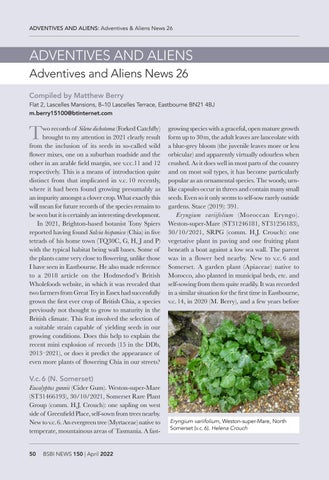ADVENTIVES AND ALIENS: Adventives & Aliens News 26
ADVENTIVES AND ALIENS Adventives and Aliens News 26 Compiled by Matthew Berry
Flat 2, Lascelles Mansions, 8–10 Lascelles Terrace, Eastbourne BN21 4BJ m.berry15100@btinternet.com
T
wo records of Silene dichotoma (Forked Catchfly) brought to my attention in 2021 clearly result from the inclusion of its seeds in so-called wild flower mixes, one on a suburban roadside and the other in an arable field margin, see v.cc.11 and 12 respectively. This is a means of introduction quite distinct from that implicated in v.c. 10 recently, where it had been found growing presumably as an impurity amongst a clover crop. What exactly this will mean for future records of the species remains to be seen but it is certainly an interesting development. In 2021, Brighton-based botanist Tony Spiers reported having found Salvia hispanica (Chia) in five tetrads of his home town (TQ30C, G, H, J and P) with the typical habitat being wall bases. Some of the plants came very close to flowering, unlike those I have seen in Eastbourne. He also made reference to a 2018 article on the Hodmedod’s British Wholefoods website, in which it was revealed that two farmers from Great Tey in Essex had successfully grown the first ever crop of British Chia, a species previously not thought to grow to maturity in the British climate. This feat involved the selection of a suitable strain capable of yielding seeds in our growing conditions. Does this help to explain the recent mini explosion of records (15 in the DDb, 2013–2021), or does it predict the appearance of even more plants of flowering Chia in our streets?
growing species with a graceful, open mature growth form up to 30 m, the adult leaves are lanceolate with a blue-grey bloom (the juvenile leaves more or less orbicular) and apparently virtually odourless when crushed. As it does well in most parts of the country and on most soil types, it has become particularly popular as an ornamental species. The woody, urnlike capsules occur in threes and contain many small seeds. Even so it only seems to self-sow rarely outside gardens. Stace (2019): 391. Eryngium variifolium (Moroccan Eryngo). Weston-super-Mare (ST31246181, ST31256183), 30/10/2021, SRPG (comm. H.J. Crouch): one vegetative plant in paving and one fruiting plant beneath a boat against a low sea wall. The parent was in a flower bed nearby. New to v.c. 6 and Somerset. A garden plant (Apiaceae) native to Morocco, also planted in municipal beds, etc. and self-sowing from them quite readily. It was recorded in a similar situation for the first time in Eastbourne, v.c. 14, in 2020 (M. Berry), and a few years before
V.c. 6 (N. Somerset)
Eucalyptus gunnii (Cider Gum). Weston-super-Mare (ST31466193), 30/10/2021, Somerset Rare Plant Group (comm. H.J. Crouch): one sapling on west side of Greenfield Place, self-sown from trees nearby. New to v.c. 6. An evergreen tree (Myrtaceae) native to temperate, mountainous areas of Tasmania. A fast50
BSBI NEWS 150 | April 2022
Eryngium variifolium, Weston-super-Mare, North Somerset (v.c. 6). Helena Crouch


